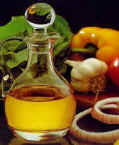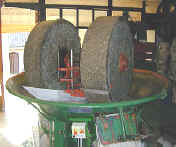|
Your online resource for all things culinary |
|
|||||||||
|
||||||||||
|
||||||||||
| Â | ||||||||||
|
||||||||||
Grades of Olive OilOlive oil is graded according to its flavor, colour, and aroma, as well as its acidity. As mentioned above, many factors contribute to the overall quality, but below are the basic requirements for each type.  Premium Select (fine) Extra-Virgin Olive OilÂThis is the cr�me de la cr�me of olive oils. It has a rate of acidity which is less than 1% with some as low as .225%. This level of quality is achieved through hand harvesting and cold pressing within 24 hours, thus ensuring the highest degree in both quality and taste.  Extra-Virgin Olive OilAny olive oil that is less than 1% acidity, produced by the first pressing of the olive fruit through the cold pressing process can be classed as an extra virgin oil but a word of warning - many extra virgin olive oils are extra virgin in name only, meeting only the minimum requirements. 'Extra virgin' is a chemical requirement that does not necessarily indicate quality or taste. In general, the deeper the colour, the more intense the olive oil flavor.  Virgin Olive OilThis is made from olives which are slightly riper than those used for extra-virgin oil. Whilst it is still unrefined, it has a slightly higher level of acidity (1-1/2 to 2%) and is generally milder than extra virgin olive oil.  Pure Olive OilThis is solvent-extracted from the olive pulp, skins, and pits then refined (also called commercial grade oil).  It is lighter in colour and blander than virgin olive oil. The word "pure" refers to the fact that no non-olive oils are added. Other than that, its mediocrity is such that it's really not a worthy competitor for cupboard space.   Buying and storing Olive OilA personal note from the Editor: Â
When buying olive oil in bulk, transfer into smaller containers, preferably to a dark-coloured bottle as air, heat, and light will cause olive oil to turn rancid. Always store in a coolish, dark place and be sure containers are tightly sealed. Avoid plastic containers as the oil can absorb PVCs.  In very cold conditions, olive oil may turn cloudy and even solidify, but it will clear again as it warms up, so cloudiness should not be taken as an indication that the oil isn't still usable. Olive oil can be refrigerated but doing so will cause it to congeal and turn cloudy although it should not affect flavoUr. Olive Oil and HealthDue to its fatty acid composition, olive oil has a beneficial impact on controlling cholesterol levels and thus has a unique part to play in the prevention of cardiovascular disease.  It is also believed that antioxidant substances such as vitamins E, K and polyphenols which are found in olive oil, delay aging and prevent carcinogenesis, liver disorders and inflammations. It is very well tolerated by the stomach and is believed to lower the incidence of gallstone formation as well as promoting bone mineralisation, and is therefore excellent for those who have bone calcification problems.  All in all, a superb ingredient as far as health benefits are concerned.   Olive
Oil
in Cooking
 Cooking with olive oil is like cooking with wine: never use an olive oil that does not taste or smell at its best.  Since olive oil is not distressed during extraction, it's very stable, especially for frying. Contrary to common belief, deterioration when frying is much lower in olive oil than in other oils. Try adding a little olive oil to the pan when a recipe calls for frying in butter. A higher temperature can be achieved with less fear of the butter burning.  Also like wine, different flavours of olive oil are best suited to different uses. As a general guide, use a milder olive oil with grilled fish, raw, cooked or steamed vegetables, soups and pasta sauces and use the fruity, stronger olive oils with grilled meats, pastas, cooked vegetables, cheeses and Bruschetta. But most of all EXPERIMENT.  Olive oil can also be used very successfully in baking, replacing or reducing the need to use butter or margarine.  |
||||||||||
Â
|
||||||||||
| Â | ||||||||||


 Before
we can talk fully about olive oil, mention must be made of the tree which
produces the fruit from which it is extracted. Olive
trees have a life span of 300 to 400 years and grow to a height of 6m/20 feet or
more. Depending on the
variety, they produce fruit varying from green to black however, olive oil is
only made from green olives and just as with wine, the flavour, colour, and
consistency vary due to different olive types, location,
and weather.Â
Before
we can talk fully about olive oil, mention must be made of the tree which
produces the fruit from which it is extracted. Olive
trees have a life span of 300 to 400 years and grow to a height of 6m/20 feet or
more. Depending on the
variety, they produce fruit varying from green to black however, olive oil is
only made from green olives and just as with wine, the flavour, colour, and
consistency vary due to different olive types, location,
and weather.  Once
picked, the traditional method of obtaining olive oil starts with the crushing the washed and stemmed olives with
huge stone wheels, however this has been surpassed by commercial hydraulic
machinery in many instances. Whether
traditional or modern, the process remains the same. Once crushed the paste is
pressed, ensuring heat isn't allowed to build up as this affects the flavour
(cold pressing), then the resulting liquid is separated into water and
oil, nowadays often using a centrifugal separator.Â
Once
picked, the traditional method of obtaining olive oil starts with the crushing the washed and stemmed olives with
huge stone wheels, however this has been surpassed by commercial hydraulic
machinery in many instances. Whether
traditional or modern, the process remains the same. Once crushed the paste is
pressed, ensuring heat isn't allowed to build up as this affects the flavour
(cold pressing), then the resulting liquid is separated into water and
oil, nowadays often using a centrifugal separator.Â